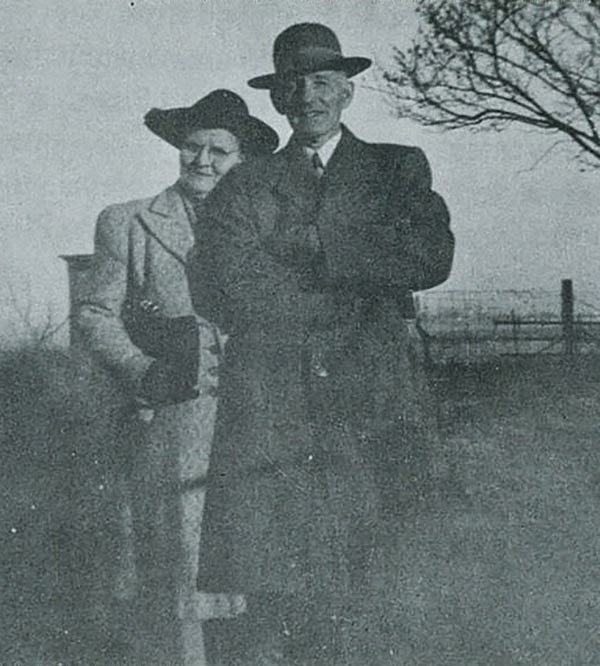 |
| Matthew Gamlin (1879-1949) |
The woman who died was Mary Bechtel Carriker Gamlin. She was known as "Molly" and she was the aunt of Phyllis (Bechtel) Peger. Joe Gamlin (my grandfather), had known Molly for a few years because she had courted and eventually married his best friend, Jess Carriker. Molly and Jess lived in Decatur where Jess was in the restaurant business. Jess was hit and killed by a train in 1912. When Joe got word of Jess' death, he contacted Roscoe Hough right away, and the two of them traveled to Decatur in Hough's horse drawn black hearse to bring Jess Carriker's body back to Raymond. It was Joe who comforted Molly, Joe who brought Molly back home, and Joe, who became her second husband. As you might imagine, the intricacies of Joe and Molly's relationship with each other did not go unnoticed by the townsfolk.
 |
| Wilma and Joe Gamlin in the 1940's |
As the Gamlin family and a neighbor gathered around the kitchen table for breakfast, cheerfully discussing the honeymoon and the charivari hosted by their friends the night before, Matthew Gamlin walked downstairs carrying a double-barrel shotgun. With no warning, he shot Molly in the face at close range. My great-grandmother's warm kitchen turned into a murder scene that morning. The force of the blast pushed Molly against the back of the chair and into the wall. She came forward again, in slow-motion, her torso crashing down on the kitchen table, silverware, glass, and bits of china flying in all directions. In a matter of seconds, a massive amount of blood began soaking into her white lace blouse, and trickled down onto the floor, pooling beneath her black, high-buttoned boots. The gunshot shook the house, rattling the teacups in the china cabinet in the sitting room.
I've often thought about the lives that were changed that day. Poor Molly who suffered so much pain in her short life was gone, and the man who would become my grandfather was left with nothing but memories and a photo of a young, pretty woman with jet black hair that he would carry in his wallet for the rest of his life. And then there was the Bechtel family who lost a young daughter, and the Carrikers' who, within a span of a couple of years, had lost their son and former daughter-in-law.
Matthew Gamlin was sent to the Asylum for the Insane at Jacksonville. Joe personally accompanied his brother to Jacksonville, just the two of them traveling alone in Joes' horse and buggy.
In 1918, Joe Gamlin married Wilma McCallum, and they farmed south of Raymond for three years before moving to what was later known as Anderberg Hill (located on the Nokomis Blacktop, opposite of Mulch's hill). Their only child, Eileen (my mother), was born there in 1924.
Security at the mental hospital in Jacksonville was relaxed, and Uncle Matt would sometimes wander off. On these occasions, the hospital would notify my grandparents that Matt was missing. Grandma was terrified that he was on his way back to kill her, just like he had killed Molly, and she refused to be in the house alone. When grandpa was at work, grandma would take my mom outside and they would sit on the well on the top of the hill, scanning the fields, watching for any sign of him. My grandma's torture went on for years, until Matthew Gamlin died on November 1, 1949.
Joe did not want Matt to be buried anywhere near Molly's grave in Asbury Cemetery, so his body was placed a few rows away in an unmarked grave near some of our other Gamlin relatives. Shortly before my Mom died in 2008, she had a small grave marker placed at the site. I was glad she did that.
I am a firm believer that everything happens for a reason. Although this story is tragic, I'm thankful that the events happened exactly the way they did, and that I am here to talk about it!
Security at the mental hospital in Jacksonville was relaxed, and Uncle Matt would sometimes wander off. On these occasions, the hospital would notify my grandparents that Matt was missing. Grandma was terrified that he was on his way back to kill her, just like he had killed Molly, and she refused to be in the house alone. When grandpa was at work, grandma would take my mom outside and they would sit on the well on the top of the hill, scanning the fields, watching for any sign of him. My grandma's torture went on for years, until Matthew Gamlin died on November 1, 1949.
Joe did not want Matt to be buried anywhere near Molly's grave in Asbury Cemetery, so his body was placed a few rows away in an unmarked grave near some of our other Gamlin relatives. Shortly before my Mom died in 2008, she had a small grave marker placed at the site. I was glad she did that.
I am a firm believer that everything happens for a reason. Although this story is tragic, I'm thankful that the events happened exactly the way they did, and that I am here to talk about it!

No comments:
Post a Comment